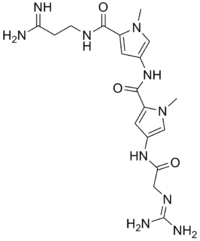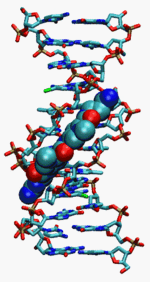- Netropsin
-
Netropsin  Other namesNt, Congocidin, Sinanomycin
Other namesNt, Congocidin, SinanomycinIdentifiers CAS number 1438-30-8 
ChEMBL CHEMBL553984 
Properties Molecular formula C18H26N10O3 · 2HCl Molar mass 503.39 g/mol Appearance White powder  (verify) (what is:
(verify) (what is:  /
/ ?)
?)
Except where noted otherwise, data are given for materials in their standard state (at 25 °C, 100 kPa)Infobox references Netropsin is an oligopeptide with antibiotic and antiviral activity.
Netropsin was discovered by Finlay et al. and first isolated from the actinobacterium Streptomyces netropsis.[1] It belongs to the class of pyrrole-amidine antibiotics. Synonyms for the compound are Congocidin and Sinanomycin.[2]
Contents
DNA binding properties
Netropsin binds to the minor groove of AT-rich sequences of double stranded DNA [3]. In contrast, Netropsin does not bind single stranded DNA or double stranded RNA. Crystallographic structures of DNA-bound Netropsin have been obtained and elucidate details of how the drug binds in the minor groove [4] [5]. In the bound structure, the drug makes hydrogen bonding interactions with four subsequent base pairs of the DNA duplex, locally displacing the water molecules of the spine of hydration.
 Netropsin (shown in space-filling representation) bound to DNA (shown as bonds). Image was created from the crystallographic structure (Protein Data Bank accession code 101D) using the software VMD (Visual Molecular Dynamics).
Netropsin (shown in space-filling representation) bound to DNA (shown as bonds). Image was created from the crystallographic structure (Protein Data Bank accession code 101D) using the software VMD (Visual Molecular Dynamics).
Using gel mobility and analytical ultracentrifugation, it was shown that Netropsin binding to DNA increases the twist per base by similar to 9˚ per molecule bound [6] [7]. Therefore, it removes supercoils when interacting with positively supercoiled DNA and introduces (additional) negative supercoils when binding to relaxed or negatively supercoiled DNA. Netropsin's effect on supercoiled DNA was observed in detail at the single-molcule level using a magnetic tweezers [8].
Antibiotic properties
It has been shown that Netropsin is active both against Gram-positive bacteria and Gram-negative bacteria [9].
See also
- Lexitropsin
- Hoechst 33258
- DNA-binding protein
- Single-strand binding protein
- Nucleic acid simulations
References
- ^ A.C. Finlay, F. A. Hochstein, B. A. Sobin, and F. X. Murphy, J. Am. Chem Soc. 73 341-343 (1951)
- ^ http://www.sigmaaldrich.com/catalog/search/ProductDetail/SIGMA/N9653
- ^ C. Zimmer and U. Wähnert, Prog. Biophys. Molec. Biol. 47 31-112 (1986)
- ^ M. L. Kopka, C. Yoon, D. Goodsell, P. Pjura, and R.E. Dickerson, J. Mol. Biol. 183 553-563 (1985)
- ^ M. L. Kopka, C. Yoon, D. Goodsell, P. Pjura, and R.E. Dickerson, Proc. Natl. Acad. Sci. USA 82 1376-1380 (1985)
- ^ G. Snounou and A. D. B. Malcolm, J. Mol. Biol. 167 211-216 (1983)
- ^ H. Triebel, H. Bär, R. Geuther, and G. Burckhardt, Progr. Colloid. Polym. Sci. 99 45-54 (1995)
- ^ J. Lipfert, S. Klijnhout, and Nynke H. Dekker, "Nucleic Acids Res." "38" 7122-32 (2010)
- ^ C. Zimmer and U. Wähnert, Prog. Biophys. Molec. Biol. 47 31-112 (1986)
Categories:- Peptides
- Antibiotics
- DNA-binding substances
- Imidazoles
Wikimedia Foundation. 2010.
